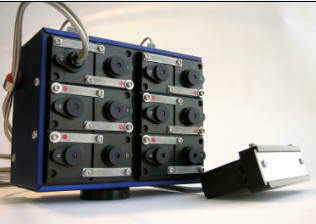The
ILS umbilical cable that connects the down-looking cameras to
the up-looking ILS plate may either be snaked through an
aircraft or routed along the outside of the craft. The ILS
plate measures approximately 1.4 inches on each side or about
1.7 inches in diameter. The minimum bend radius of the
umbilical cable is 1.5 inches. Tighter bends may permanently
damage the umbilical cable.
The weight that an Incident Light Sensor
adds to a Mini-MCA is made up of the weight of the ILS plate with
its filters and the weight added by the fiber-optic umbilical.
The latter depends upon its length. The weight of a five
channel ILS with five filters is 40 grams. The weight added
by the umbilical is 40 grams per meter. The weight of a
Mini-MCA6 ILS with 5 filters and with a 25 cm umbilical would be
50 grams. The weight of a Mini-MCA12 ILS plate with 11
filters would be 88 grams. The umbilical is a double cable
which adds 80 grams (2 x 40 g) per meter. The weight
of a Mini-MCA12 ILS with 11filters and with a 25 cm umbilical
would be 108 grams. The total umbilical length for an ILS may range from 1/4 meter to two meters.
 |
 |
| 5 Channel Mini-MCA with 5 Channel Incident
Light Sensor |
11 Channel Mini-MCA with 11 Channel Incident
Light Sensor |
The Incident Light Sensor may be ordered with new Mini-MCA systems or existing system owners may contact Tetracam, obtain an RMA, ship their Mini-MCA systems to our Chatsworth facility and have an ILS added to their system. Contact our sales office at 818-397-0469 or send email to info@tetracam.com for current pricing or further details.
|
